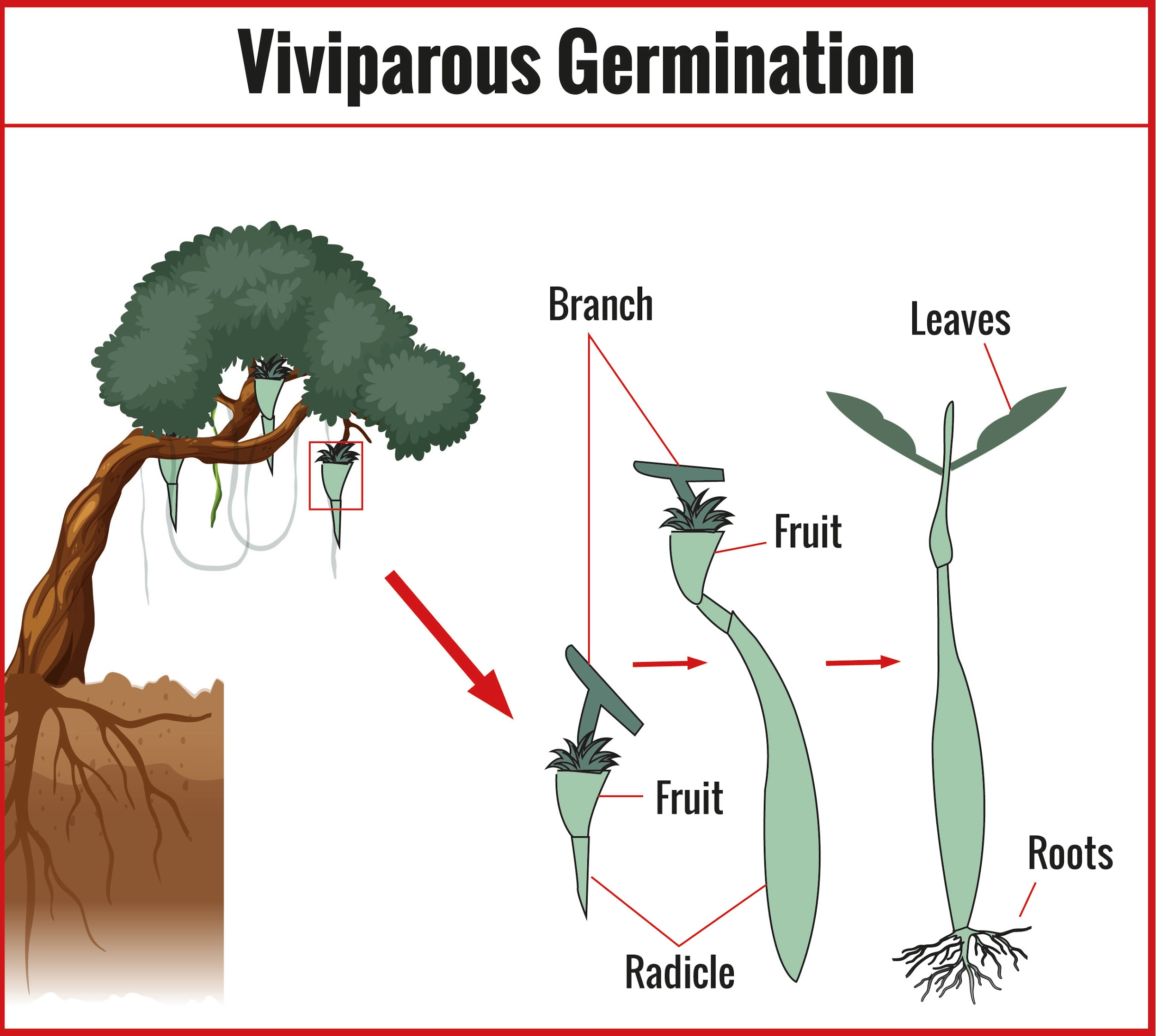
Characteristic feature of mangrove plants is
(a)Apospory
(b)Heterospory
(c)Parthenocarpy
(d)Vivipary
Answer
475.5k+ views
Hint: The type of reproduction in which seed germination takes place within the fruit while it is still attached to the plant is a characteristic feature of mangrove plants. For example, Rhizophora, Avicennia, Sonneratia, Salsola, etc.
Complete answer:
Mangroves are viviparous, because while the propagule is attached to the parent tree, mangroves spread propagules or embryonic development.
Mangroves are marshy areas near seashores found in tropical deltas and saline ponds. Vivipary or seed germination is an essential feature of mangrove plants when the fruit is attached to the plant. Before it sinks into the saline marsh, the seedling spreads enough. Only the portion of the radicle moves into the water or mud, while the part of the plumule remains above the water level. Examples include Rhizophora, Aegiceras, Ceriops.
In plants, when seeds or embryos begin to develop until they separate from the parent, vivipary occurs. Cormlets grow in the axils of their inflorescences in plants such as Iridaceae and Agavoideae. This fall and they essentially have the start of a whole season over fallen seeds in favorable circumstances.
Similarly, some Crassulaceae develop and drop plantlets from notches in their leaves, ready to grow, such as Bryophyllum. Such embryo development from somatic tissues is an asexual reproduction of the vegetative that amounts to cloning.
Additional Information:
Apospory involves the production of diploid gametophytes from vegetative cells of the sporophyte, without meiosis and spores. Mosses and ferns, for example.
Heterospory is a condition where two different size spores are formed. The microspore is male and they are smaller in size while the larger megaspore is female by the land plant's sporophytes. Pteridophytes -selaginella, and Salvinia are some examples.
Parthenocarpy is the growth of fruit without fertilization, which leaves the fruit seedless. The example of parthenocarpic fruits is pineapple and banana.
So, the correct answer is, ‘Vivipary’.
Note: In the subtropical and tropical regions of the world, mangrove forests grow on land near coastlines.
Mangrove woods are the most significant vegetation found in coats that have accumulated mud and silt in the areas of tide-influenced coats. In order to be exposed to sunlight, the roots of mangroves are formed as the marshy swamps limit oxygen intake.

Complete answer:
Mangroves are viviparous, because while the propagule is attached to the parent tree, mangroves spread propagules or embryonic development.
Mangroves are marshy areas near seashores found in tropical deltas and saline ponds. Vivipary or seed germination is an essential feature of mangrove plants when the fruit is attached to the plant. Before it sinks into the saline marsh, the seedling spreads enough. Only the portion of the radicle moves into the water or mud, while the part of the plumule remains above the water level. Examples include Rhizophora, Aegiceras, Ceriops.
In plants, when seeds or embryos begin to develop until they separate from the parent, vivipary occurs. Cormlets grow in the axils of their inflorescences in plants such as Iridaceae and Agavoideae. This fall and they essentially have the start of a whole season over fallen seeds in favorable circumstances.
Similarly, some Crassulaceae develop and drop plantlets from notches in their leaves, ready to grow, such as Bryophyllum. Such embryo development from somatic tissues is an asexual reproduction of the vegetative that amounts to cloning.
Additional Information:
Apospory involves the production of diploid gametophytes from vegetative cells of the sporophyte, without meiosis and spores. Mosses and ferns, for example.
Heterospory is a condition where two different size spores are formed. The microspore is male and they are smaller in size while the larger megaspore is female by the land plant's sporophytes. Pteridophytes -selaginella, and Salvinia are some examples.
Parthenocarpy is the growth of fruit without fertilization, which leaves the fruit seedless. The example of parthenocarpic fruits is pineapple and banana.
So, the correct answer is, ‘Vivipary’.
Note: In the subtropical and tropical regions of the world, mangrove forests grow on land near coastlines.
Mangrove woods are the most significant vegetation found in coats that have accumulated mud and silt in the areas of tide-influenced coats. In order to be exposed to sunlight, the roots of mangroves are formed as the marshy swamps limit oxygen intake.

Recently Updated Pages
Master Class 12 Economics: Engaging Questions & Answers for Success

Master Class 12 Maths: Engaging Questions & Answers for Success

Master Class 12 Biology: Engaging Questions & Answers for Success

Master Class 12 Physics: Engaging Questions & Answers for Success

Master Class 12 Business Studies: Engaging Questions & Answers for Success

Master Class 12 English: Engaging Questions & Answers for Success

Trending doubts
Give simple chemical tests to distinguish between the class 12 chemistry CBSE

Define peptide linkage class 12 chemistry CBSE

Draw a labelled sketch of the human eye class 12 physics CBSE

Differentiate between lanthanoids and actinoids class 12 chemistry CBSE

Phenol on treatment with conc HNO3 gives A Picric acid class 12 chemistry CBSE

Differentiate between homogeneous and heterogeneous class 12 chemistry CBSE




